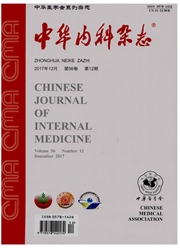

 中文摘要:
中文摘要:
目的 评价以左氧氟沙星为基础的三联疗法和铋剂四联疗法作为二线疗法根除幽门螺杆菌(Hp)的临床疗效,为Hp初次根除失败后的补救治疗提供临床用药依据.方法 在PubMed、Cochrane Library、SPRINGER、维普、万方数据及中国知网数据库检索含左氧氟沙星三联疗法(含左氧三联组)和铋剂四联疗法(铋剂四联组)在首次根除Hp失败后作为二线疗法根除Hp的RCT研究,采用改良Jadad评分方法对文献的质量进行评价,采用RevMan5.3软件进行数据分析,根据异质性检验结果选择合并效应量模型并进行Meta分析.绘制漏斗图对潜在的发表偏倚进行评估.结果 最终纳入17篇文献.虽然含左氧三联组的根除率高于铋剂四联组,但差异无统计学意义(77.0%比68.7%,OR=1.52,95% CI0.96 ~2.42,P=0.34).亚组分析显示,欧洲地区含左氧三联组的根除率明显高于铋剂四联组(80.6%比68.5%,OR=2.18,95% CI 1.25 ~ 3.81,P<0.05),亚洲地区两种方案疗效的差异无统计学意义.7d方案的含左氧三联组与铋剂四联组Hp根除率的差异无统计学意义,而10 d方案的含左氧三联组的疗效明显优于铋剂四联组(87.7%比61.3%,OR=4.92,95% CI3.09 ~7.82,P<0.05).亚组分析显示,左氧氟沙星剂量对Hp根除率无明显影响;含左氧三联组的不良反应发生率明显低于铋剂四联组(19.1%比29.5%,OR=0.47,95% CI0.26~0.82,P<0.05),而依从性明显高于铋剂四联组(96.0%比89.9%,OR=2.27,95% CI 1.33 ~ 3.87,P<0.05).结论 相比于铋剂四联疗法,左氧氟沙星为基础的三联疗法作为补救手段根除Hp的总体疗效更高,不良反应发生率更低,患者依从性更好,推荐10 d方案的左氧氟沙星为基础的三联疗法作为首次根除Hp失败后的二线疗法,但在喹诺酮类药物耐药率高的地区不建议采用.
 英文摘要:
英文摘要:
Objective To evaluate the efficacy of levofloxacin-based triple therapy and bismuthbased quadruple therapy in the treatment of Helicobacter pylori (Hp) infection as rescue regimens.Methods Related randomized controlled trials assessing the efficacy and safety of levofloxacin-based triple therapy eradicating Hp as salvage treatment were retrieved from Pubmed,Cochrane Library,SPRINGER,VIP database,WanFang database and CKNI database.The literature quality was evaluated by the improved Jadad criterion.RevMan5.3 sofeware was applied to data analysis.The mergment model was chosen on the basis of the outcome of the heterogeneity tests and original data was pooled for meta-analysis.Publication bias assessed with funnel plots.Results Ultimately seventeen literatures were included for meta-analysis,the analysis showed that the eradication rate of levofloxacin-based triple therapy was higher comparing to the bismuth-based quadruple therapy but the difference was not statistically significant (77.0% vs 68.7%,OR =1.52,95% CI 0.96-2.42,P =0.34).In European countries,levofloxacin-based triple therapy was more effective than quadruple therapy(80.6% vs 68.5%,OR =2.18,95% CI 1.25-3.81,P 〈 0.05),while eradication rates of two groups in Asian countries were similar.The 7-day levofloxacin-based triple therapy and quadruple therapy showed comparable efficacy,whereas the 10-day levofloxacin-based triple therapy was significantly more effective than quadruple therapy (87.7% vs 61.3%,OR =4.92,95% CI 3.09-7.82,P 〈 0.05).The efficacy was not influenced by the dose of levofloxacin.The adverse effects were significantly lesser(19.1% vs 29.5%,OR =0.47,95% CI 0.26-0.82,P 〈 0.05),whereas the compliance rate was significantly higher in levofloxacin group (96.0% vs 89.9%,OR =2.27,95% CI 1.33-3.87,P 〈 0.05).Conclusions Comparing with bismuth-based quadruple therapy,levofloxacinbased triple therapy has higher eradication rate,compliance rate and lesser side effects,so we recommend it as a second-line rescue therapy a
 同期刊论文项目
同期刊论文项目
 同项目期刊论文
同项目期刊论文
 期刊信息
期刊信息
